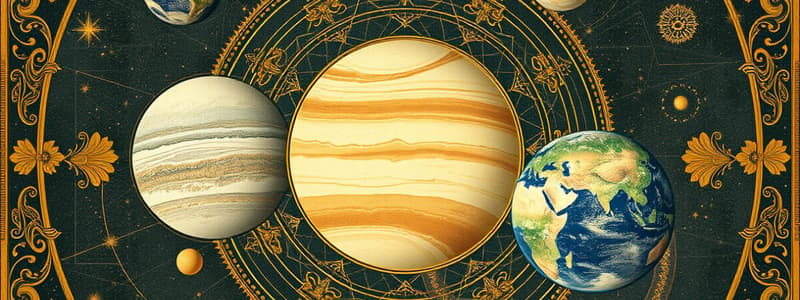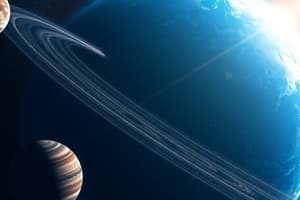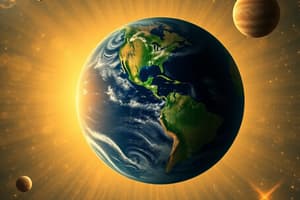Podcast
Questions and Answers
Which planet has a thick atmosphere causing extreme heat?
Which planet has a thick atmosphere causing extreme heat?
- Earth
- Mercury
- Venus (correct)
- Mars
What is the primary component of the cores of terrestrial planets?
What is the primary component of the cores of terrestrial planets?
- Hydrogen
- Helium
- Silicate
- Iron (correct)
Which of the following terrestrial planets has no moons?
Which of the following terrestrial planets has no moons?
- Venus (correct)
- Mercury (correct)
- Mars
- Earth
Which gas giant has the longest revolution period around the Sun?
Which gas giant has the longest revolution period around the Sun?
Which terrestrial planet rotates in the opposite direction compared to the others?
Which terrestrial planet rotates in the opposite direction compared to the others?
Which planet is classified as the largest in size?
Which planet is classified as the largest in size?
What is the distance of Earth from the Sun in Astronomical Units (AU)?
What is the distance of Earth from the Sun in Astronomical Units (AU)?
Which gas giant is known for its prominent rings?
Which gas giant is known for its prominent rings?
Flashcards are hidden until you start studying
Study Notes
Terrestrial Planets
- Include Mercury, Venus, Earth, and Mars; classified as rocky and solid, or Earth-like.
- Composed of a core mainly made of iron and a silicate mantle.
- Can feature canyons, craters, mountains, and volcanoes.
- Closest planets to the Sun, in order: Mercury (0.4 AU), Venus (0.7 AU), Earth (1 AU), Mars (1.5 AU).
- Astronomical Units (AU): 1 AU = approximately 93 million miles or 150 million kilometers.
- Size comparison: Mercury is the smallest, Earth is the largest, with Venus and Earth being similar in size.
- Moons: Mercury and Venus have none, Earth has one, Mars has two.
- Atmospheres: Mercury has virtually none, Earth supports life, Mars has a thin atmosphere (mostly carbon dioxide), Venus has a thick carbon dioxide atmosphere causing extreme heat.
- Rotation: Mercury takes 88 days to revolve around the Sun; Mars takes 687 days; both Earth and Mars rotate on their axes in about 24 hours.
- Venus rotates slowly and in the opposite direction of other terrestrial planets.
Gas Giants (Jovian Planets)
- Include Jupiter, Saturn, Uranus, and Neptune; characterized by massive sizes and gaseous composition.
- Jupiter is the largest planet, significantly larger than Earth; even Neptune is still larger than Earth.
- Revolving times: Jupiter (4331 days), Saturn (10,747 days), Uranus (30,589 days), Neptune (59,800 days).
- All gas giants have ring systems, with Saturn being most notable for its prominent rings.
- Low densities: Jupiter (1.3 g/cm³), Saturn (0.7 g/cm³), compared to Earth's density of 5-5.5 g/cm³, meaning Saturn could float in water.
- Lack a true solid surface; primarily composed of hydrogen, helium, and traces of methane.
- Deeper layers consist of swirling gases and liquid.
- Moons: Jupiter has 79, Saturn 62, Uranus 27, and Neptune 14 moons.
Terrestrial Planets
- Mercury, Venus, Earth, and Mars are classified as terrestrial or rocky planets due to their solid surfaces.
- Each terrestrial planet has a core primarily composed of iron, surrounded by a silicate mantle.
- Surface features include canyons, craters, mountains, and volcanoes.
- Proximity to the Sun is: Mercury (0.4 AU), Venus (0.7 AU), Earth (1 AU), and Mars (1.5 AU).
- 1 Astronomical Unit (AU) equals approximately 93 million miles (150 million kilometers).
- Size hierarchy: Mercury is the smallest, Earth is the largest, while Venus and Earth are similar in size.
- Moons: Mercury and Venus have no moons, Earth has one moon, and Mars has two moons.
- Atmospheric conditions vary: Mercury has a negligible atmosphere, Earth has a life-supporting atmosphere, Mars has a thin atmosphere largely made of carbon dioxide, and Venus features a thick carbon dioxide atmosphere leading to extreme greenhouse heat.
- Rotation characteristics: Mercury completes a revolution around the Sun in 88 days; Mars takes 687 days; both Earth and Mars spin on their axes roughly every 24 hours.
- Venus exhibits a slow rotation and spins in the opposite direction compared to the other terrestrial planets.
Gas Giants (Jovian Planets)
- Jupiter, Saturn, Uranus, and Neptune are classified as gas giants with immense sizes and gaseous compositions.
- Jupiter, the largest planet, is considerably bigger than Earth, and Neptune is still larger than Earth.
- Revolution times are lengthy: Jupiter (4331 days), Saturn (10,747 days), Uranus (30,589 days), Neptune (59,800 days).
- All gas giants possess ring systems, with Saturn distinguished by its prominent and intricate rings.
- Gas giants have low densities: Jupiter at 1.3 g/cm³ and Saturn at 0.7 g/cm³, significantly less than Earth's density of 5-5.5 g/cm³, indicating Saturn could float in water.
- They lack a definitive solid surface and are primarily composed of hydrogen, helium, and small amounts of methane.
- Their internal structure consists of swirling gaseous and liquid layers.
- Moon counts: Jupiter has 79 moons, Saturn has 62, Uranus has 27, and Neptune has 14 moons.
Studying That Suits You
Use AI to generate personalized quizzes and flashcards to suit your learning preferences.




